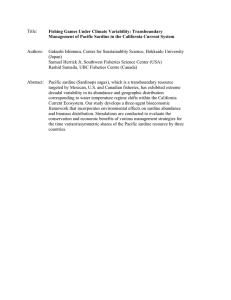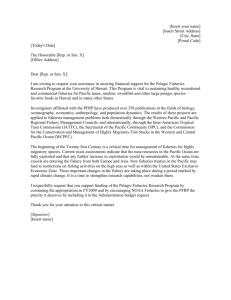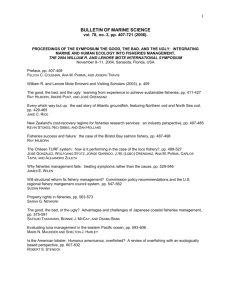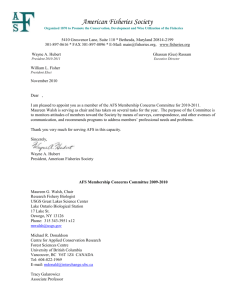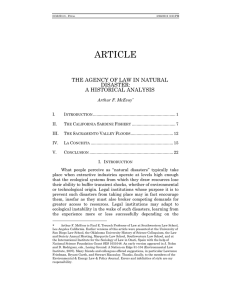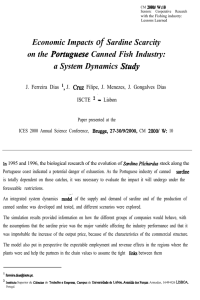fisheries crisis
advertisement
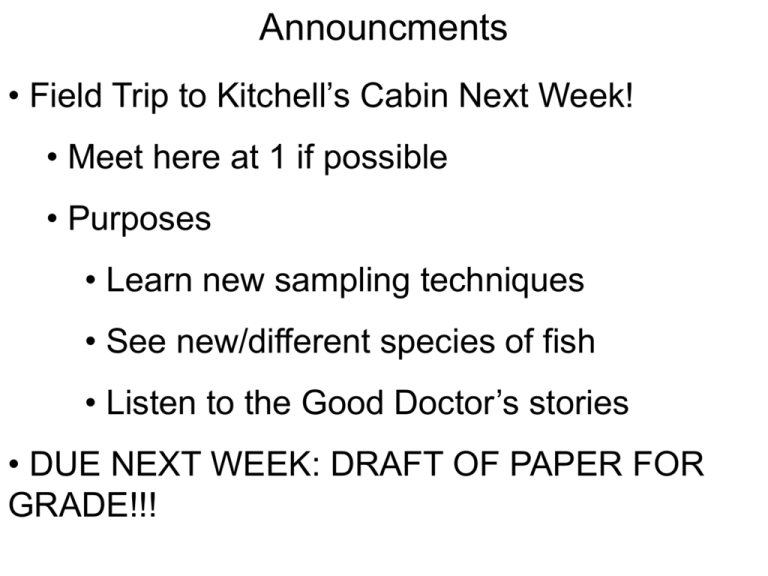
Announcments • Field Trip to Kitchell’s Cabin Next Week! • Meet here at 1 if possible • Purposes • Learn new sampling techniques • See new/different species of fish • Listen to the Good Doctor’s stories • DUE NEXT WEEK: DRAFT OF PAPER FOR GRADE!!! Outline for the Day • Lingering Questions? • Reading Quiz 2 and Announcement of Other Quiz • Discussion of Worm et al. 2006 • Fisheries Crisis Lecture • Break • Foraging Behavior and Diets Lecture • Diet Analysis Lab Reading Quiz 2 1.The authors argue that the loss of what has had a great impact on marine fisheries? 2. How do the authors define “collapsed fishery”? 3. What is meant by the abbreviation “LME” 4.What management practice do the authors suggest for marine fisheries? Discussion Topics Was this a good or a poor paper? Discuss the strengths and weaknesses of the authors’ arguments Evaluate this statement: “This trend is of serious concern because it projects the global collapse of all taxa currently fished by the mid-21st century” Scientists as Advocates • Is it possible to be both a good scientist and a good advocate? • How has advocacy hindered scientific advancement? • How has advocacy helped science? 2006 : Worm et al. = 0 trained fisheries stock assessors (I think) response 2006 : Worm et al. Catch ≠ Abundance NMFS reported in 2004 26% of stocks were overfished, in 2005 24% of stocks ....shall we extrapolate to show that US fisheries will be fine by 2018, no ! if you do the same thing with German unemployment it says no one in Germany will be working by 2056 (100% unemployment) Fisheries Crisis Goals • Context of paper, Background to widespread issue in fisheries • Global Trends in Fisheries • Maximum Sustainable Yield • Examples of Collapsed Fisheries • Management Goals for Fisheries http://www.fao.org http://www.fao.org Maximum Sustainable Yield Agriculture Term Population Growth Population Size K K/2 Time dN = rN K-N K dt K/2 Population Size Logistic Growth Equation K Population Size Recruitment Rate Populations influenced by other forces Catch exceeds recruitment K/2 Year MSY is "perfect condition" Population Size California Sardine Fishery California Sardine Fishery California Sardine Fishery • Sardine demand increased when use shifted from human consumption to fishmeal and oil circa 1920 • No catch limits: State scientists issue warning that draining supplies should be avoided until research can detect overfishing • 1930s: catch no longer increases in proportion to increases in effort. California state scientists recommend a limit • US Bureau of Fisheries, hesitant to limit a successful economic enterprise during the Depression, deemed limits unnecessary b/c evidence of sardine depletion, while strong, was not “clear-cut”. • 1939: CA state experts replaced with “emergency appointees” and state opinion mysteriously changes from “fishery is depleted” to “all is well”. • 1942: Sardine fishery collapses. Only began to recover in 1980s. Species Peak Date Peak Landing First First Warning Limits Crash Crash Landing Current Landing CA Sardine 1938 800,000 tonnes Mid 1920s 1942 140,000 (hit 0 by 1952) 0 tonnes 1942 North Atlantic Cod North Atlantic Cod North Atlantic Cod • Optimism in 1970s that past mistakes (sardine) could be avoided • Fishing intensity grew in 1960s with peak catch in 1968 • Canada extends jurisdiction from 12 to 200 nautical miles offshore in the late 1970s • Allowed the setting of conservative restrictions on catches to 20% of the total stock to promote rebuilding • 1988 the Dept. of Fisheries and Oceans claimed a 5x increase in Northern Cod since 1976; tooted horn as a shining example of what cautious, science driven management could do for fisheries • 1992: No cod left to catch; loss of fishery cost several billion $ • Science drastically underestimated stock size, resulting in much more than 20% being harvested – for any year, data from 5 subsequent years was needed to estimate stock. Shorter time periods simply returned the assumed mortality rate Species Peak Date Peak Landing (Tonnes) First First Warning Limits Crash Crash Landing Current Landing 2003-05 CA Sardine 1938 800,000 Mid 1920s 1942 1942 140,000 (hit 0 by 1952) 0 North Atlantic Cod 1968 800,000 1989 1976 1992 0 6,000 Bluefin Tuna Bluefin Tuna • Bluefin and other tuna species were relatively unregulated until the 1980s, in part due to it being an international fishery • 1981 recommendation from international commission recommended reducing tuna fishing to as near to 0 as possible • Lobbyists convince commission to reduce fishing by 55% instead of a ban • Continuing trend of reducing fishing by less then recommended • Total collapse still feared, total ban still considered, Japan working on artificially raising young tuna Species Peak Date Peak Landing (Tonnes) First First Warning Limits Crash Crash Landing Current Landing 2003-05 CA Sardine 1938 800,000 Mid 1920s 1942 1942 140,000 (hit 0 by 1952) 0 North Atlantic Cod 1968 800,000 1989 1976 1992 0 6,000 Bluefin Tuna 1960 115,000 1981 1982 1992/yet to be seen 45,000 58,000 Management Goals • Biological: MSY • Economic • Social Management Goals Management Strategies for Sustainable Fisheries Protected Areas Dedicated Access Rest of CFL Kitchell Kornis Weidel Economic Incentives Precautionary Regulation Characteristics of Sustainable Fisheries Good Governance Appropriate Incentive Dedicated Access Open Access Kitchell • Lowered demand for fish • Wealth • Knowledge of complex ecosystems • Cooperation between fisheries and other governmental agencies
